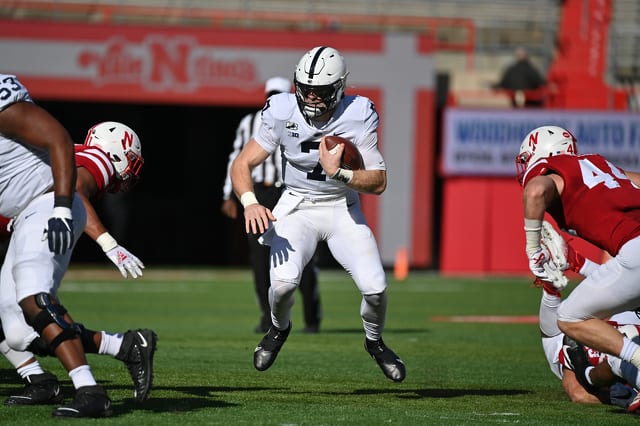It’s often forgotten the word prospect has a lot more to do with the future than the present. For many, a player being a highly rated prospect implies a flattened learning curve. You don’t wait for a prospect to become a star, they simply start out that way. While it’s not unreasonable to think a recruit might immediately make a positive impact on a team the word prospect speaks to what a player might become, not what a player currently is. Failure to make that impact off the batt doesn’t mean a player is a bust, it just means they aren’t quite there yet. And that’s okay.
When it comes to former Penn State quarterback Will Levis, he has long held the title of “future NFL starting quarterback prospect” and it’s not hard to understand why. Levis has an absolute cannon for an arm, he’s tall [6-foot-3] and according to ESPN he hits the scales at 232 pounds. Levis is the quintessential body type and build that NFL scouts love and has physical traits you can’t teach.
According to a post by Pro Football Focus [PFF] on Wednesday afternoon, Levis is currently the second-best quarterback prospect in the entire 2023 draft class behind Alabama quarterback and Heisman finalist Bryce Young. In and of itself, Levis being a highly rated prospect isn’t particularly new, most of his time at Kentucky has been centered around the idea he could one day turn his prospect label into reality. So this isn’t about what Levis can become – or that he absolutely won’t succeed in the NFL – because only time will answer that question. It’s also not to say Levis’ big frame, strengths and experiences are things that scouts shouldn’t appreciate and value.
But when you go home this holiday season or when family comes to you, eventually your football-loving and Penn State-loving family members are going to bring up Sean Clifford and Will Levis. And both of you are going to debate if Penn State would have won more games with Levis at the helm. He’s a highly rated prospect after all.
Of course anything is possible. Penn State lost to Ohio State in no small part because of four turnovers Clifford had a hand in. There are also other games throughout Clifford’s career that a more deft touch – which Levis does not appear to possess – may have helped the cause. Nevertheless “had someone else thrown that pass would it have gone better?” is a fruitless but inevitable thought experiment that transcends this particular debate.
That said, let’s consider a few things.
Interceptions. For all of his shortcomings at any given moment, Clifford has 15 interceptions to his name over the past two seasons. Clifford’s 15 interceptions span over the course of 758 passing attempts, or rather an interception once every 50 passing attempts. As for Levis, the Wildcat gunslinger has 23 interceptions to his name over the last two seasons in just 636 attempts, a rate of one interception every 27.6 attempts. Depending on how good you are at rounding, that’s not far off from an interception rate twice that of Clifford’s.
To be fair interceptions are a fickle thing not always the fault of a quarterback, but consider usage as well. Levis left Penn State having started multiple games but still when it was all said and done, ran the ball more times than he threw it. There is admittedly some nuance to this fact, but it does not appear to be a mistake a player who has thrown interceptions at a fairly high rate [Kentucky ranked 87th in the nation this year in interceptions thrown and 88th in passing offense] while as a starter at Kentucky was generally not called on to throw the ball while at Penn State.
Additionally, Kentucky ranks 114th in the nation in passes attempted, and while being a run-oriented offense is a perfectly fine thing, it’s strange to think a team could possess a Top 2 quarterback talent but actively have very little interest in throwing the ball. In his first year as as starter Kentucky ranked 88th in passing attempts in 2021.
As for the games Penn State actually lost under Clifford it’s hard to see how any iteration of what Levis has done in college would have been the difference. That’s maybe where the comparisons need not start or begin in the first place. This season Penn State was outgunned against Michigan and nearly beat Ohio State. Clifford’s four interceptions loom large in that game, but replacing Clifford for a statistically more turnover prone Levis doesn’t exactly scream “solution to problem” in that case. Back up to 2021 and the Nittany Lions were admittedly a bit of a mess, but Clifford generally wasn’t the root cause of such issues. If anything a healthy Clifford was often the thing Penn State missed the most.
In short whatever type of NFL player Levis becomes, he wasn’t that player in college. So while you might be longing for a version of history where Sean Clifford wasn’t Penn State’s starting quarterback, Levis almost certainly wasn’t the answer either.



